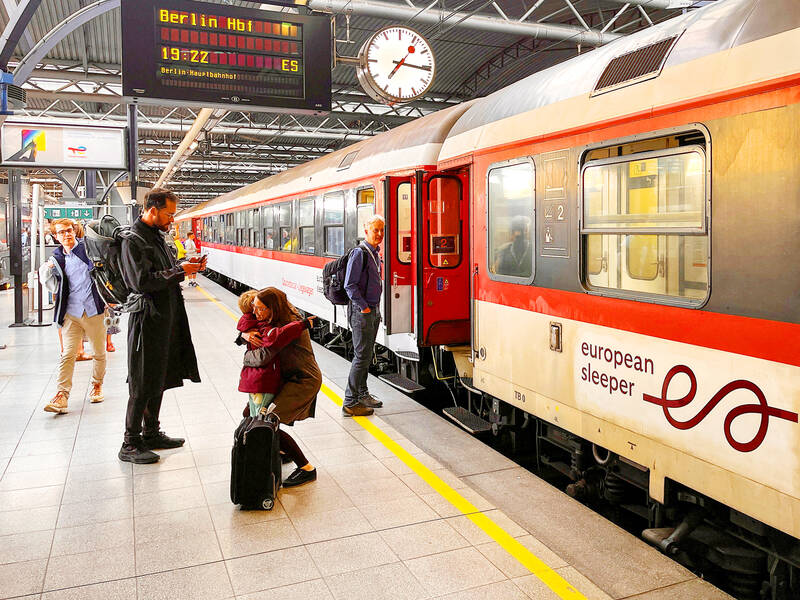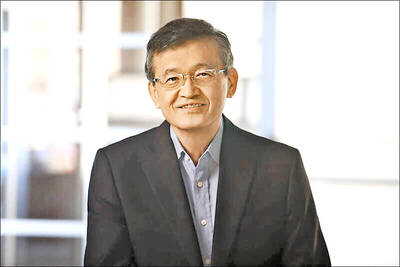After being gently rocked awake in her sleeper cabin, Sarah Marks spent the morning of her 29th birthday watching the Alps zip past the windows of her overnight train to Zurich.
“The train comes in right next to the lake, with the mountains coming up behind it,” Marks said. “Very romantic, I have to say.”
By the time of that 2022 journey from Zagreb, Croatia, it had been four years since she had taken a flight — since around the time Swedish climate activist Greta Thunberg began to spread the term flygskam, or “flight shame.”

Photo: Reuters
An increasing number of climate-conscious Europeans, particularly younger travelers, are shunning carbon-spewing airplanes in favor of overnight trains. In the process, they have spurred something of a night-train revival, while discovering what many say is a slower, richer way of traveling, one that had been on the edge of extinction.
“Being able to fall asleep in one city and wake up maybe even in another country, it’s amazing to me,” said Marks, a Londoner who grew up flying several times a year. “When I switched the plane for the train, it was a no-brainer because, also, this is a superior experience.”
Although still a niche and relatively pricey market, demand for sleeper trains is increasing. The online platform Trainline said overnight bookings last year rose 147 percent from 2019, the year before the COVID-19 pandemic.
A European Investment Bank climate survey found that 62 percent of respondents supported a ban on short flights.
Governments have begun to reinvest in overnight trains as they search for ways to meet targets to reduce carbon emissions by 2030. The European Commission selected three new night routes in a pilot program aimed to support cross-border travel, including some ambitious private start-ups.
“Government investment is somehow going back to the good old days of when railways were providing a public service,” said Poul Kettler, one of the founders of Back on Track, a pan-European rail advocacy group. “The climate is coming with a price tag, and they’re now willing to pay.”
Sleeper trains never completely disappeared, particularly in Eastern Europe, but advocates say they suffered years of underinvestment while budget airlines sold tickets for a fraction of the cost.
National railways pivoted resources to high-speed daytime rail, and governments promoted more short-haul air travel by expanding airports and mostly exempting jet fuel from taxes.
The supposed death knell for sleeper trains arrived when Germany’s Deutsche Bahn AG shuttered their remaining overnight routes in 2015.
However, the turnaround began almost immediately. Austria’s railway, OBB, gambled on night trains by buying all of Germany’s sleeper carriages. They renovated the cars, rebranded it Nightjet and applied cost-saving lessons from the airline industry.
Now, Nightjet runs 22 international sleeper routes, mostly in Central Europe, but extending from Vienna to Paris and Hamburg to Rome.
In December last year, Nightjet began rolling out 33 new seven-car trains complete with room key cards, cellphone-permeable window panes for better photographs, and digital thermostats in each compartment.
Nightjet probably saved the entire night-train industry, said Thibault Constant, a former engineer at National Company of the French Railways (SNCF), with 250,000 followers on his Simply Railway Youtube channel.
The atmosphere on sleeper trains has changed dramatically, he said.
“Ten years ago, it was only old people and weirdos taking night trains,” Constant, 27, said while riding a train through the Czech Republic. “Now I take the same lines with a bunch of teenagers and all kinds of people.”
The success of Nightjet showed other national railways that sleeper trains were worth upgrading, advocates say.
For instance, the Czech and Hungarian railways last year began refurbishing their sleeper cars and national operators in Italy and Finland signed contracts for new ones.
Private companies also are stepping in to fill gaps in service. European Sleeper launched last year — partially relying on crowdfunding — with service from Brussels to Berlin via Amsterdam, and extended the line to Prague in May. The European Commission selected the company’s plans for an Amsterdam-to-Barcelona route among its pilot projects.
Still, progress is slow-going.
A much-hyped French proposal in 2021 to invest US$1.5 billion in overnight trains still has not begun, Back on Track said, although France did revive four overnight lines from Paris to the south in the past two years.
Meanwhile, Spain’s Renfe discontinued the last of its Trenhotel lines in 2020 with no plans announced to bring them back.
Challenges include the lack of a central booking platform for train tickets; the more than 30 European operators each have their own Web sites.
It is also hard to make night trains profitable, considering that a day-running train car has about 70 seats, compared with the 20 to 40 berths on an average night train.
There is also the issue of price, and competition from budget airlines. For example, a 14-hour overnight train ride in late April form Paris to Berlin on Nightjet was going for 139 euros (US$152) for a bunk in a four to six-person couchette, whereas a flight on budget carrier Transavia was 50 euros. Private cabins on the train can cost significantly more, while reclining seats are similar to the price of a flight.
However, Marks said that a sleeper car saves travelers the price of a hotel night, not to mention the cost of traveling to city centers from far-flung airports. Headline flight prices rarely include fees for bags, seat assignments and other extras.
Sleeper-car buffs say the experience is worth some extra effort and cost.
“What’s better than snuggling down in crisp, clean sheets with a bottle of wine while you travel, and then you’re there the next morning?” said Mark Smith, whose Web site Man in Seat 61 is a guide to European train travel. “It’s quite fun.”

Intel Corp chief executive officer Lip-Bu Tan (陳立武) is expected to meet with Taiwanese suppliers next month in conjunction with the opening of the Computex Taipei trade show, supply chain sources said on Monday. The visit, the first for Tan to Taiwan since assuming his new post last month, would be aimed at enhancing Intel’s ties with suppliers in Taiwan as he attempts to help turn around the struggling US chipmaker, the sources said. Tan is to hold a banquet to celebrate Intel’s 40-year presence in Taiwan before Computex opens on May 20 and invite dozens of Taiwanese suppliers to exchange views

Application-specific integrated circuit designer Faraday Technology Corp (智原) yesterday said that although revenue this quarter would decline 30 percent from last quarter, it retained its full-year forecast of revenue growth of 100 percent. The company attributed the quarterly drop to a slowdown in customers’ production of chips using Faraday’s advanced packaging technology. The company is still confident about its revenue growth this year, given its strong “design-win” — or the projects it won to help customers design their chips, Faraday president Steve Wang (王國雍) told an online earnings conference. “The design-win this year is better than we expected. We believe we will win

Chizuko Kimura has become the first female sushi chef in the world to win a Michelin star, fulfilling a promise she made to her dying husband to continue his legacy. The 54-year-old Japanese chef regained the Michelin star her late husband, Shunei Kimura, won three years ago for their Sushi Shunei restaurant in Paris. For Shunei Kimura, the star was a dream come true. However, the joy was short-lived. He died from cancer just three months later in June 2022. He was 65. The following year, the restaurant in the heart of Montmartre lost its star rating. Chizuko Kimura insisted that the new star is still down

While China’s leaders use their economic and political might to fight US President Donald Trump’s trade war “to the end,” its army of social media soldiers are embarking on a more humorous campaign online. Trump’s tariff blitz has seen Washington and Beijing impose eye-watering duties on imports from the other, fanning a standoff between the economic superpowers that has sparked global recession fears and sent markets into a tailspin. Trump says his policy is a response to years of being “ripped off” by other countries and aims to bring manufacturing to the US, forcing companies to employ US workers. However, China’s online warriors